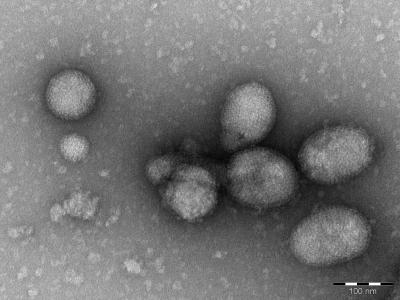
Ferak is a fantasy figure, a plant/animal hybrid creature. The genome of the virus has similarities to bunyaviruses from both plants and animals. Researchers at the University of Bonn and the German Center for Infection Research (DZIF) have discovered two new groups of viruses within the Bunyavirus family in the tropical forest of Ivory Coast. Previously only five groups responsible for serious illnesses in humans and animals were known. Most are spread through blood-feeding insects. Based on the discovered viruses researchers conclude that the ancester to all bunyaviruses must have existed in arthropods such as insects. The results are now being published in the "Proceedings of the National Academy of Sciences" (PNAS).
The bunyavirus family includes five different groups of viruses which trigger serious illnesses in humans and animals and which can also cause significant damage to vegetables, such as tomatoes. The first viruses of this family were discovered in a place known as Bunyamwera in Uganda, from which they derive their name. "The most well-known bunyaviruses include, for example, the Rift Valley fever virus, which can cause febrile illnesses with severe bleeding in humans," says Dr. Sandra Junglen from the Bonn Institute of Virology, also affiliated with the German Center for Infection Research. In 2011, the "Schmallenberg virus" gained much attention: also a part of the Bunyavirus family and transmitted by gnats, it caused severe fetal malformations in ruminant animals including sheep in the German Sauerland region.
Not in Schmallenberg but instead in the African tropical forest of the Ivory Coast, where the virologist has been conducting research for more than ten years, she set off on the search for new viruses. Because most bunyaviruses are transmitted by blood-sucking insects, Dr. Junglen caught more than 7500 mosquitoes. Sorted according to species and sites of capture, the scientists combined the captured mosquitoes into 432 mixed samples. In 26 of these samples, the researchers discovered particles of unknown bunyaviruses.
Agents of human disease have developed from insect viruses
"These were two groups of as-yet-unknown viruses which we called Jonchet virus and Ferak virus," reports the virologist. The scientists obtained fragments of the viral genetic material from the insect samples and joined these fragments together like a puzzle, thus reconstructing the entire genome sequence. "That alone took four years," reported lead authors Marco Marklewitz and Florian Zirkel. During the comparison of the genetic information with other viruses, it was found that Jonchet and Ferak viruses are two phylogenetically independent bunyavirus lineages.
How dangerous are the two new groups of viruses - can they be easily transmitted to humans and animals? To answer these questions, the scientists went in a new direction: They performed infection trials in a large number of cell cultures at different temperature levels. While pathogenic bunyaviruses can multiply at temperatures that include the human body temperature, growth of Jonchet and Ferak viruses ceases above 32 degrees Celsius, making it unlikely that the viruses infect humans or other vertebrates. "In addition, we reconstructed the evolutionary history of host associations of the entire family of viruses, demonstrating for the first time that viruses affecting vertebrates developed from arthropod-specific viruses," says the researcher from the University of Bonn Hospital.
Simplified test to test novel viruses for risk of human infection
Triggered by epidemics such as SARS and Ebola, virologists are now reaching out to discover the plethora of unknown viruses lurking in natural reservoirs such as insects, in an attempt to forecast pandemic risks. „We hope our temperature test for estimating the risk of vertebrate infection can be useful for assessing other viruses that keep being discovered," says Dr. Junglen.
Source: University of Bonn
 Print Article
Print Article Mail to a Friend
Mail to a Friend
